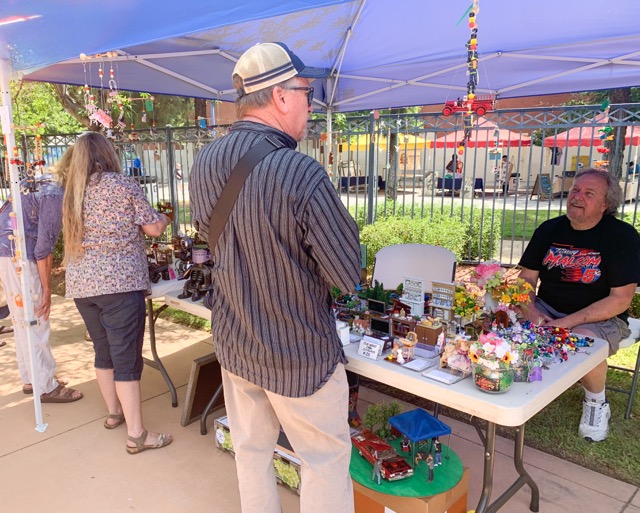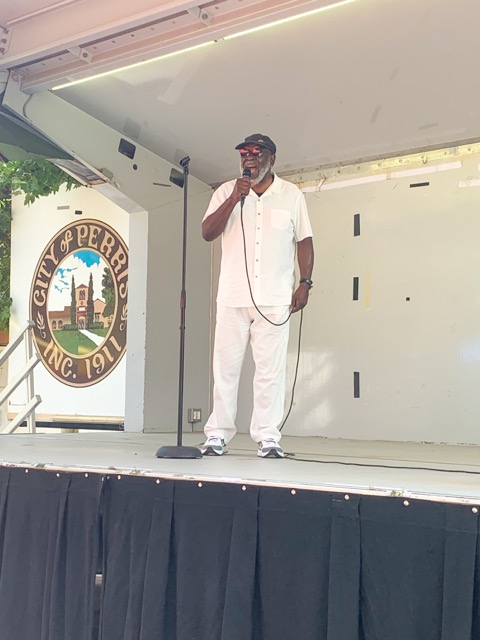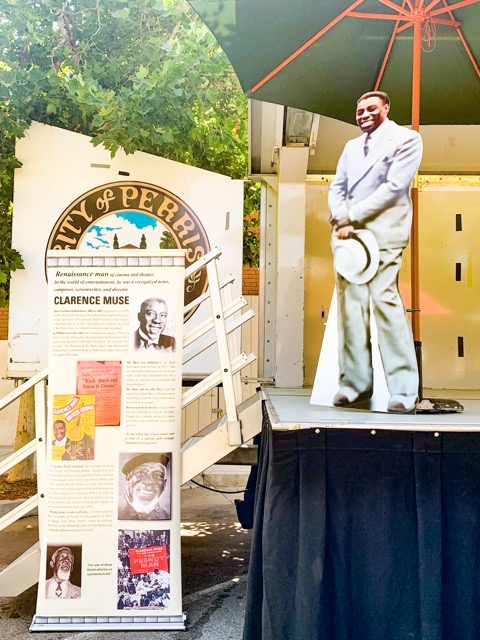Clarence Muse
BY MIA ROTELL
Beneath the shade of old trees and the melodies of live jazz, dozens of people gathered at the Santa Fe Depot Garden in the City of Perris for the 60th Annual Clarence Muse Art Festival recently, celebrating the art and honoring the legacy of a man whose impact still echoes through the city today.
His name lives on, but memories of the profound impact Clarence Muse had in developing the contemporary identity of the Perris Valley area fade as a photograph with time. Descriptions of the warm and welcoming personality and the specifics of his benevolence and achievements gather dust on the shelves of the Perris Valley Historical and Museum Association, founded in 1964 by Clarence Muse himself, among others.
The following year, as a member of the first historical association board, Muse was one of the creators of the art festival that bears his name. The festival now is, as it was then, a gathering for local children to paint, make pottery, sing, dance, and celebrate the arts.
The proceeds from this year’s festival are dedicated to celebrating the legacy and lifting the memory of Muse, to gain for him a long-deserved star on the Hollywood Walk of Fame. It’s been 51 years since he was an initial inductee into the Black Filmmakers Hall of Fame in 1973, alongside luminaries Ossie Davis, Paul Robeson, and Sammy Davis, Jr.

A native of Baltimore and adopted son of Perris, Muse was first a groundbreaking and prolific entertainer: actor, director, screenwriter, composer, and musician for over fifty years. He starred in the first predominantly African American acted “talkie” film, “Hearts in Dixie” in 1929, and acted in a reported 200 films, the last being “Black Stallion” in 1979, the year he passed away in Perris, one day before his 90th birthday.
He collaborated with greats of the era, including co-starring in a film with former world heavyweight boxing champion Joe Louis in “Spirit of Youth”. Muse co-wrote the film “Way Down South,” with famed poet, activist, and leader of the Harlem Renaissance, Langston Hughes. He was a writer of what became a signature song of legendary jazz great Louis Armstrong, “Sleepy Time Down South.” He was the first African American director on Broadway, achieving the role in 1941. Never one to allow cobwebs to gather, Muse appeared in the 1976 cult hit, “Car Wash,” while in his late eighties.
Muse moved to Perris in 1934 and occupied his whimsically named ranch, Muse-a-While, until his death.
Muse’s 300-acre plot was located off Highway 74 in the unincorporated, undeveloped community outside Perris. He dedicated 160 acres to a working ranch where he kept flocks of egg-producing chickens. He’d send eggs to military bases during World War II, where he’d also perform for the troops.
The Perris of the day was quite different than the Perris of today. Residents grew their own produce, such as white rose potatoes, alongside a variety of grains, and took care of livestock on far-reaching acres of land. The produce was shipped out of the Santa Fe Train Depot, built in 1892, to sell in remote locations.
Adopting the spirit of the ranch name, Muse welcomed visitors and travelers alike with open arms. He and his 3rd wife, Irene Ena Kellman, whom he married in 1954, invited friends and family over for dinner and provided travelers a place to stay in one of the many bungalows on the property.

In the days of segregation and Jim Crow laws throughout the south, “The Green Book” guided African American travelers to safe cities where they could stay. Muse-a-While in Perris, CA, was one of them.
Celebrating the memory of Muse, by enlightening visitors to his legacy, historians and nearby museums set up booths with exhibits at this year’s festival.
Lovella Singer with The Dora Nelson African American Art and History Museum in Perris, displayed photos, his filmography, and pages from. “The Green Book” featuring Muse-a-While.
“‘The Green Book’ became a very important guide for black travelers. He had bungalows on his wild ranch where travelers could stay,” Singer said.
“Clarence deserves this more than anybody,” said long-time Perris Valley Historical and Museum Association volunteer Katie Keyes. “He helped the children and really created the community. He gave water to the small town between Perris and Lake Elsinore.”

It was his love and dedication to local children, the future of Perris, that so many underscore, what some believe drove him to push this city to be bigger.
Muse put his love for Perris’s children to work by providing lunch to the kids who didn’t have any. He would often drive from each elementary school in the area to drop off bagged lunches to children because there was no school lunch program in place.
He also founded “Christmas Hollow,” which was his own Christmas, where he dressed as Santa and gifted children toys that they may not have gotten otherwise.
“I recently realized I never liked regular Santa Claus because the only Santa I knew was Clarence. I didn’t like white Santas, I was so used to my family friend, Clarence,” personal family friend of Muse, Joanne Camena said.
“He was such a great person as far as being down to earth,” Perris Valley Historical and Museum Association President and friend, Steve Stenlake added.
“And just really likable and caring. I mean, he did everything for the kids of Perris,”
He loved the community,” museum association treasurer Dennise Manning said. “I think that’s why he moved here. And he loved the children.”
The museum held a showing of Muse’s greatest clips, including one of Muse’s feature films, “Riding High,” starring crooner Bing Crosby and directed by Frank Capra of “It’s a Wonderful Life” fame.
Paintings, illustrations, and historic art pieces covered the courtyard fences and offered themselves to the highest bidder. Perris Valley Historic Museum donated pieces for a silent auction, with the minimum bidding from $10 to $30.
Regina Enriquez, President of the Perris Valley African American History Committee, says that she’s been working with fellow Perris residents to raise the money for Muse’s star on or near Hollywood Blvd. “It makes me feel really proud and happy to be part of this community.”
Most fans don’t know that there is a fee, currently $85,000, to cover the creation, installation, and maintenance of the Hollywood Walk Stars. This fee is typically paid by the recipient’s studio, label, agency, or fans.
Forty-six years after his death, only the fans remain. The event on May 31st raised approximately $8,000, upping the total to $46,000, leaving another $40,000 to go.

Dozens of Perris historians and residents alike honor what Muse has done for the city. Through his help, he gave Perris a strong sense of community that continues today after first purchasing his land 91 years ago. He mentored residents, provided children with food, was actively involved in PTA meetings, and worked diligently to help the city. Clarence Muse was a warm face around town. Those who personally remember him recall that nothing would stop his efforts to ensure everyone was happy.
“We will do this every single year and keep asking for money until he has a star in Hollywood,” Manning said.
A 30-minute documentary film about Clarence Muse may be viewed here: https://digital.library.unt.edu/ark:/67531/metadc1983636/m1/
To contribute to the effort to secure a Star on the Hollywood Walk of Fame, the Perris Valley Historical & Museum Association is accepting checks mailed to P.O. Box 343, Perris, CA, 92572, and they accept Venmo at Perris Valley Historical Museum, @PerrisValleyHistoricalMuseum. Contact Katie Keyes for all donation inquiries, (951) 657-0274.
For More Perris News Visit www.zapinin.com/perris


